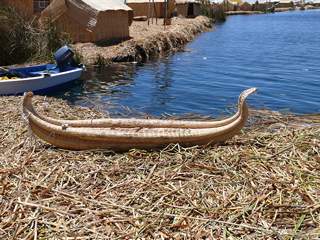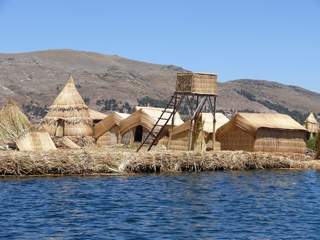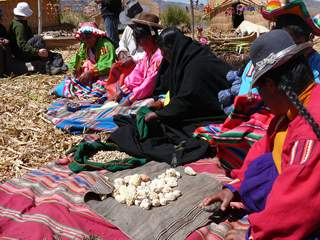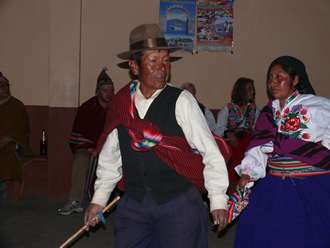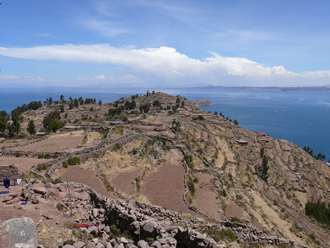Fascinating TITICACA and its ISLANDS

|
As we left Puno port the boat motored through a channel
lined with Tortora Reeds. Within half an hour we reached the Uros floating
Islands (about 48 of them). The islands are made of large blocks of reed roots
held together by ropes with layer upon layers of fresh reeds on top. The reeds
are a source of food (the white inner juicy bit near the root) it taste a bit
like celery. It is also the basic materiel for roofs and walls. It is used for
cooking fuel and to make wonderful rafts. These floating islands are anchored
down at each corner with a long nylon rope and heavy
weight. There are about 600 Uros Indians living in these islands
today. They are a mix of Quechua and Aymaru blood. Life has never been easy for them but modern day living
has improved through tourism and they seem fairly
content.
Motoring through the reeds
Beautiful reed boats
even for the young
Floating villages
Rio Wily Island
Welcoming Party
New found friend
Bartering demo
All mode cons!
Kitchen
Farewell
committee As we approached Amantani Island where we were staying
the 1st night, a crowd of men and women in traditional costumes were
lined up awaiting their 25 guests
We were advised by our guidebook and tour operator that
it would be a nice gesture to bring our hosts (2 in our case) some rice, sugar, salt
and fruits. We had great fun buying in the market 2 kilos( in separate bags) the
latter not forgetting carrots, apples, tangerines, 10 pencils, biros and books.
It weighed about 18 kilos in all. We started to climb laden with our rucksacks and goodies.
Chris had to be excused in a hurry. Delhi
Belly or in this case Puno, is not
ideal when you are carrying very heavy weights up steep hills and
suffering from breathlessness due to altitude. Jenny, our host, was very tolerant and advised us to walk
slowly. Our guide was young and very energetic. He invited
everyone to meet at 4 pm and play a game of football with the locals before we
climbed up to the Temple at the top of the Island to watch the sunset. Chris
decreed that next time we would choose an older
guide. We had a very entertaining evening with folklore music
and dancing. All the Gringos had to dress up: Ladies in skirts and men in
ponchos and hats
Our hosts were very excited at the idea of dancing and
especially the beer drinking.
Good steps
Our
host
Excellent band Chris managed 1 ½ hrs at the evening
dance. At 8 am the next morning, Jenny walked us down to the
port. Downhill was so much easier especially with only half the goody load. I
felt happy to have brought a few supplies to such a welcoming family but Chris
said he did not feel that good carrying it and that it was easier to give cash.
I replied “We already had done that and in any case they had to carry everything
up too so they would appreciate our efforts!” After an hour of rough crossing we reach Taquile Island.
Titicaca lake is 4000 mts above sea level and we walked to the top of the island
5000 mts (3 miles). No wonder we feel the altitude. Taquile has been inhabited
for over 10000 years and agriculture was introduced 4000BC. Today most of the
islanders are weavers and knitters. The island is beautiful. It has 6
communities with 3000 habitants. They have no help from central government
so they pool resources together.
The square is the hub of the community with a very modern town hall and a large
textile/handicraft building. 90% of the proceeds goes to the vendors and
10% tax to benefit the community. Inter marrying is a great
problem in the Island and creates genetic defects. To mix the gene pool they
have been permitted to marry within the neighbouring islanders but only with
Quechuans. The Mayor decides who is going to be host and it would
appear that they work as a unit. As usual we do things differently, normally visitors stay
one night, we stayed two! We waved goodbye to the party and walked to the
highest point to the ruins Uray Kari . It was magic. Utter peace, with stunning
views and scenery that would make any European real estate developers quiver
with excitement. Thank God no one apart from the islanders are able to profit
from the little tourism. We gather that a Belgian fellow tried to muscle in a
few years ago and was sent packing. Despite their primitive and simple ways, the
enjoyment of being part of a community has no
price. After 3 days of primitive living and baby wipes, the
Russian Front Hotel with its abundance of hot water was
appreciated. We are leaving early for
Cusco.
Bolivia in the back ground
Beautiful terraces
Stunning scenery
Uray Kari temple
Modern WC
sandals made out of recycled rubber (old tyres and
Conveyor belts). When worn out they make good gate
hinges.
Going to school
Married men wear Red/Blue striped hats
Unmarried women wear pompons
Unmarried ones wear the half white below
on their shawl |


